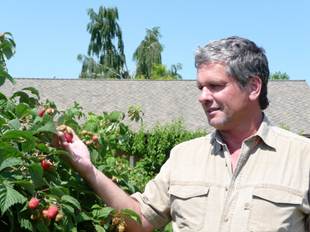By Ashley Mussbacher (The Cascade) – Email
Honey bees are recognized as the world’s pollinators, but right now their population is declining drastically each year. What’s causing these huge annual die-offs? And how will we be able to sustain the amount of fresh produce grown without them?
Tom Baumann works primarily as an instructor in UFV’s agriculture department, but also as a consultant to growers. He and agriculture sessional instructor Eric Gerbrandt addressed the concerns of the bee decline at the GreenSpeak session on October 8, expanding more on theories surrounding the bee colonies’ disappearance.
Each year the bee colony abruptly disappears; a phenomenon known as Colony Collapse Disorder (CCD). According to the Natural Resources Defense Council (NRDC), bees started disappearing in 2006. Seemingly healthy, they “would simply abandon their hives en masse, never to return.” Researchers estimated that nearly one third of all honey bee colonies in the country have simply vanished.
Reasons like malnutrition, immunodeficiencies, and pesticides were among several given at the presentation. Rumours have also brought diesel fuel and electromagnetic radiation into question, but Baumann is skeptical, saying that there is no direct evidence.
“Once in a while, you just can’t explain it,” he says.
Among the causes, pesticides are “one of the issues that we have,” Baumann says. Without pollinators, many fruits and berries would not set.
Abbotsford is known for its berry season. A giant sculpture stands in the centre of the Clearbrook traffic circle to remind us of our keystone aggregate fruit. According to BC’s raspberry industry website (bcraspberries.com), more than 80 per cent of Canada’s raspberries are grown in the Fraser Valley. With the bee population in decline, the quantity of crop is reduced, and that means hard economic times ahead.
However, there may be a solution. Research was conducted at UFV’s Pacific Berry Resource Centre to test a natural plant growth regulator that is applied to blueberries to help them set. Gerbrandt explains that the supplement is a simple solution of Gibberellic Acid (GA3), which is naturally occurring in plants. The trade name is FruitSize, and has submitted its registration as a supplement to the Canadian Food Inspection Agency (CFIA) for labelling in 2014.
The solution was tested on blueberries. It is applied at bloom and works to send the same signal to the plant as a seed would, helping the plant set without being pollinated. And since it is completely natural, Baumann says there is no harm done to the bees, the plants, or the soil. The GA3 product was tested by Canadian regulatory personnel to determine that it is harmless to the environment.
“This is not a replacement for bee pollinators,” states Gerbrandt. GA3 is an option for farmers during years when the bee population is low, to ensure an “increased number of clusters,” or fruit yield. He also adds that there is no guarantee GA3 will work on every variety of plant in any year due to variability in weather conditions.

